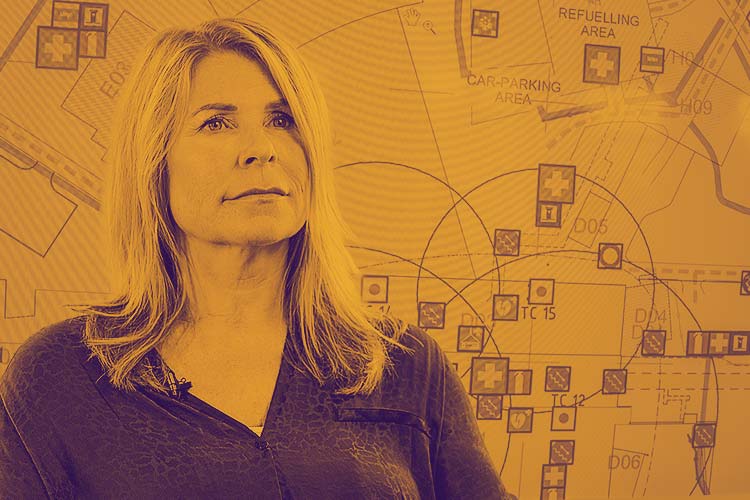Lotta Wibeck, head of Skanska Sweden’s Digital Hub, has a vision for ten years from now: everything in construction will be digitized; data sharing will be widespread, and the power of data will be harnessed so that learnings are applied across teams, projects, even companies. That’s the easy part, though, as she’ll be quick to tell you. It’s right now that’s difficult. Wibeck is confident that data sharing won’t be an option; it’ll just be the way things operate. And future professionals won’t be hesitant about digitization; it’ll be their natural way of doing things. But now, when industry veterans skeptical of tablets and digital blueprints are working alongside college graduates who grew up online, there’s a delicate but essential dance that must take place.
Wibeck has been influential in a variety of ways over the course of her career: in implementing design review standards, for instance, throughout Sweden. Wibeck has also advocated for a less complicated tech stack. Find fewer softwares you can rely on every day, and use them to do more things. That why she relies on Bluebeam Revu and Microsoft Office, programs that are agile and elastic, and that can be used throughout the lifecycle of a project.
Few people in today’s construction industry have been more adamant than Wibeck about digitizing construction smartly. Perhaps that’s the key word. If people aren’t actually making good use of the technology they have, if it doesn’t come to seem second nature, then what is its value? In the perfect world, “we don’t talk about it anymore,” Wibeck adds—people just do it.
Collecting, sharing and maximizing data
So what would a more perfect construction and design world look like? For one, more collaboration. Wibeck envisions data being shared openly across Skanska, with a searchable database going back decades. For example, say somebody is working on a bridge in Lund, in southern Sweden. “If they have a question about Bluebeam they can get help from a colleague up in the north, who they’ll never meet, who might say, aha, I have had the same issue. I solved it this way.” They might even reach out to colleagues in other countries, taking advantage of the fact that Skanska is a multi-national company. Wibeck wants Skanska to be a place “where you help each other even you are not together.”
And industry leaders might harness their data in other ways, as well. “We need to be a data-driven company. Data and facts. It’s very nice with emotions and feelings, but in the end also a lot of construction people are very stressed because of everything in their head. So sharing is caring.” One way of doing that, besides a hive mind-like network, is by taking advantage of what you’ve already got. For instance, Skanska, which is over 130 years old, has years’ worth of project information and institutional knowledge which can be translated into transferrable and mineable data. The industry needs to learn to be less guarded about how it gets things done: “I would like young people to just ask for total openness when it comes to data,” Wibeck says. “I think every company needs to share the data, because in the future it will be the people who interpret data that will be kind of the superheroes.”
Bringing the workforce together: the generation gap
And Skanska is well on its way. Wibeck senses the normalization of digitalization among the younger employees: she tells me knows the Digital Hub is succeeding when young employees “don’t talk about digital. They don’t talk about connectivity. They just talk about how proud they are of building the house, or the bridge, or the town.” And they use tools like Bluebeam and Autodesk as second nature, the way a worker with an older mindset might use a pen and paper. She’s also encouraged by the amount of peer to peer training she sees going on, and the way people know what they want to do, even if they don’t necessarily know how to get there. A perfect example of this is Jimmy Forsberg, a member of Wibeck’s Digital Hub team. Forsberg is a champion of Bluebeam has spent thousands of hours traveling the country training others in Bluebeam and advocating for design review standards, among Skanska employees as well as with peer organizations.
“It’s nice to have that challenge of being in the middle of transforming a whole industry. It would be kind of boring otherwise,” Wibeck tells me. “We have this culture of being proud that our people are problem solvers.” Lotta Wibeck is an unwavering evangelist for bringing change along by bringing people along. She knows where the industry is headed, and she knows that in order to bring her organization to that point in the most successful way possible, Skanska needs to embrace tools that people want, that allow them to share their knowledge with others, tools they’ll use often and eagerly and that, at the end of the day, they won’t really need to think about all that much. Wibeck is also an optimist, and if she’s got a guiding principle, it is perhaps something she herself said during our interview: “The one that has the courage to be open will win.”











